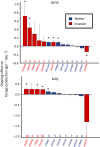Feast or famine: How is global change affecting forage supply for Yellowstone's ungulate herds?
- PMID: 36057540
- PMCID: PMC10078388
- DOI: 10.1002/eap.2735
Feast or famine: How is global change affecting forage supply for Yellowstone's ungulate herds?
Abstract
The ecological integrity of US national parks and other protected areas are under threat in the Anthropocene. For Yellowstone National Park (YNP), the impacts that global change has already had on the park's capacity to sustain its large migratory herds of wild ungulates is incompletely understood. Here we examine how two understudied components of global change, the historical increase in atmospheric CO2 and the spread of nonnative, invasive plant species, may have altered the capacity of YNP to provide forage for ungulates over the last 200-plus years. We performed two experiments: (1) a growth chamber study that determined the growth rates of important invasive and native YNP grasses that are forages for ungulates under preindustrial (280 ppm) versus modern (410 ppm) CO2 levels and (2) a field study that compared the effect of defoliation (clipping) on the shoot growth of invasive and native mesic grassland plants under ambient CO2 conditions in 2019. The growth chamber experiment revealed that modern CO2 increased the growth rates of both invasive and native grasses, and invasive grasses grew faster regardless of CO2 conditions. The field results showed a continuum of positive to negative responses of shoot growth to defoliation, with a subgroup of invasive species responding most positively. Altogether the results indicated that the historical increase in CO2 and the spread of invasive species, some of which were planted to provide forage for ungulates in the early and mid-1900s, have likely increased the capacity of forage production in YNP. However, rising CO2 has also resulted in regional warming and increased aridity in YNP, which will likely reduce grassland productivity. The challenge for global change biologists and park managers is to determine how competing components of global change have already affected and will increasingly affect forage dynamics and the sustainability of Yellowstone's iconic ungulate herds in the Anthropocene.
Keywords: Anthropocene; Yellowstone National Park; atmospheric CO2; climate change; grasslands; grazing; herbivory; invasive plants; ungulates.
© 2022 The Authors. Ecological Applications published by Wiley Periodicals LLC on behalf of The Ecological Society of America.
Conflict of interest statement
The authors declare no conflict of interest.
Figures




References
-
- Baker, H. G. , and Stebbins G. L., eds. 1965. The Genetics of Colonizing Species. New York, NY: Academic Press.
-
- Beissinger, S. R. , Ackerly A. A., Doremus H., and Machlis G. E., eds. 2017. Science, Conservation, and National Parks. Chicago, IL: University of Chicago Press.
-
- Beissinger, S. R. , and Ackerly D. D.. 2017. “Science, Parks, and Conservation in a Rapidly Changing World.” In Science, Conservation, and National Parks, edited by Beissinger S. R., Ackerly A. A., Doremus H., and Machlis G. E., 363–87. Chicago, IL: University of Chicago Press.
-
- Berger, J. 2017. “The Science and Challenges of Conserving Large Wild Mammals in 21st‐Century American Protected Areas.” In Science, Conservation, and National Parks, edited by Beissinger S. R., Ackerly A. A., Doremus H., and Machlis G. E., 189–211. Chicago, IL: University of Chicago Press.
Publication types
MeSH terms
Substances
Associated data
LinkOut - more resources
Full Text Sources

